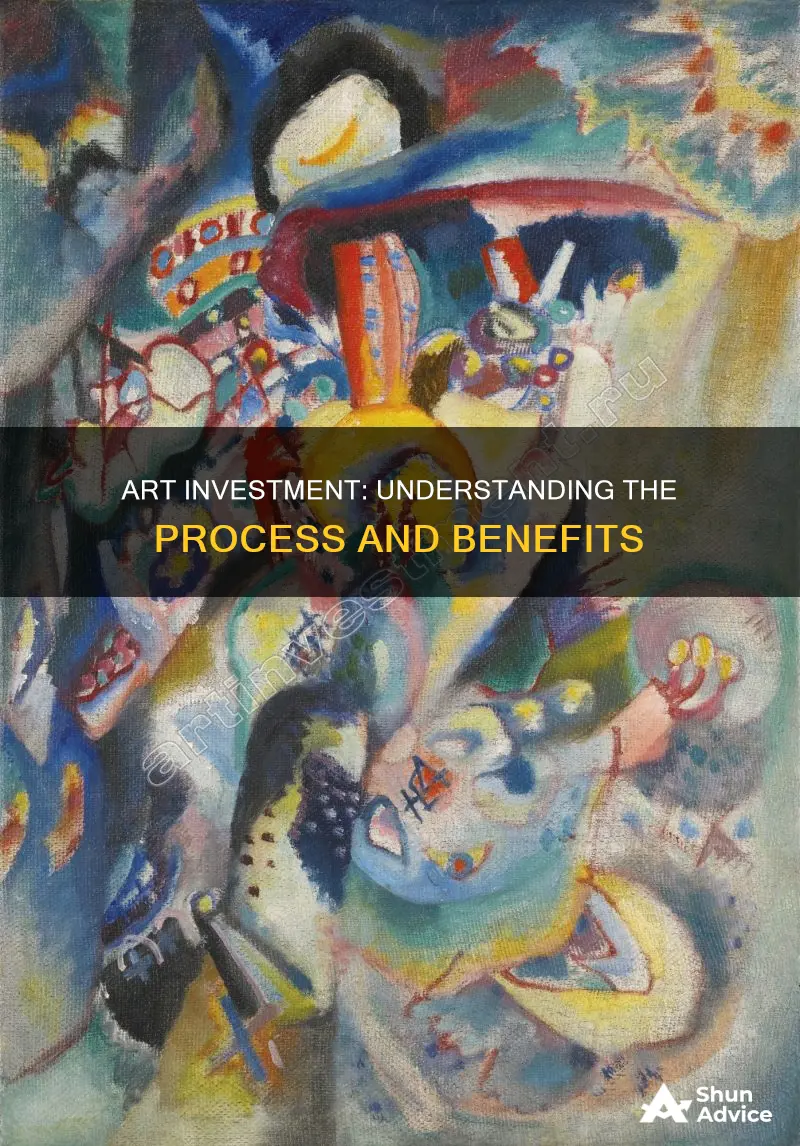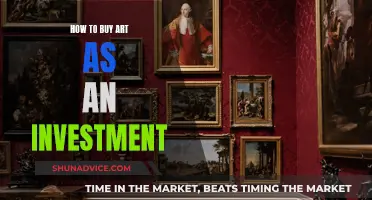
Investing in art can be a profitable venture, but it is a complex process that requires extensive research and knowledge of the art world. It is a long-term investment, and while it can provide stable returns or large payouts during prosperous periods, it is vulnerable to significant value loss during economic downturns. The value of art is determined by several factors, including the rarity of the piece, the reputation of the artist, and its condition. Investors can choose to purchase individual pieces or invest in art funds, each option presenting its own set of risks and potential rewards.
| Characteristics | Values |
|---|---|
| Type of investment | Alternative investment strategy |
| Potential for profit | Potential for significant rewards |
| Challenges | Requires extensive research, knowledge of the art world, and maintenance of the artwork |
| Risk | Art is a long-term investment that can plummet in value during recessions |
| Factors determining value | Rarity, size of the edition, significance, condition, signature and numbering by the artist |
| Buying options | Individual pieces, art funds, online platforms, auctions, galleries, direct from artists |
| Approach | Consider aesthetic pleasure first, don't rely on art investments for steady income |
What You'll Learn

Art investment funds vs individual pieces
Investing in art can be a complicated process, and it is important to understand the market and the risks involved. There are two main ways to invest in art: buying individual pieces or investing in an art fund.
Art Investment Funds
Art funds work similarly to mutual funds, but instead of investing in stocks, they invest in artwork. Masterworks is a well-known example of an art fund manager, with over 800,000 members investing in high-value works of art. Art funds conduct research and identify artworks with a good chance of increasing in value. They also take care of the maintenance required to keep the artworks in good condition. Investors in art funds buy shares in the artworks and do not take physical possession of the pieces. This makes investing in art more accessible and allows investors to buy and sell shares more easily. However, investors pay a fee for this service and do not get to enjoy the artwork in their own space.
Individual Pieces
Investing in individual pieces of art can be riskier than investing in an art fund, but it can also be more rewarding. When investing in individual pieces, it is important to have knowledge of the art world or work with someone who does. Investors should research the artist, their reputation, and the factors that determine the value of the artwork, such as rarity, condition, and significance. Buying individual pieces of art also comes with additional costs, such as insurance, storage, and authenticity certificates. However, investing in individual pieces allows investors to take possession of the artwork and enjoy it in their own space.
In conclusion, both art investment funds and individual pieces have their advantages and disadvantages. Art investment funds offer a more accessible way to invest in art and take care of the research and maintenance of artworks. On the other hand, investing in individual pieces can be riskier but potentially more rewarding, allowing investors to take possession of the artwork and enjoy it while also having the potential for higher returns.
Retirement Investment Strategies: Navigating Your Golden Years
You may want to see also

Art world knowledge
Art investment is a complex process that requires a good understanding of the art world. Here are some key considerations and insights to help navigate this potentially lucrative but challenging field:
Firstly, it is important to recognise that the art market is broad and diverse. To effectively navigate it, one must dedicate time to learning about the specific genre or time period of interest. This includes researching artists, understanding their reputations, and recognising that the value of their work can fluctuate based on their standing in the art world. Up-and-coming artists can be exciting, but their work's value will be influenced by their long-term reputation.
The rarity of a piece of art is a significant factor in determining its value. Original pieces are generally worth more than reproductions, and limited-edition prints are more valuable than mass-produced images. The size of the edition, the significance of the work, its condition, and whether it is signed and numbered by the artist, all influence its worth.
When investing in art, it is advisable to consider aesthetic pleasure before financial benefits. While art can be a profitable investment, it should not be relied upon as a primary source of income or for retirement planning. The art market can be stable or show large returns during prosperous times, but it is also vulnerable to recessions, which can cause values to plummet.
There are various ways to purchase art, including auctions, galleries, and online platforms. Online auctions can be a less intimidating option for new buyers, offering an alternative to the potentially daunting gallery environment. When acquiring art, it is essential to consider the overall influence of the artist beyond media praise and public recognition.
Finally, investing in art often requires building a professional network within the art world. This can include attending art fairs, auctions, and galleries, as well as hiring experts or consultants who can provide valuable insights and guidance on well-informed bids.
Investments: The Thrill of the Hunt
You may want to see also

Artwork value determination
Rarity and Scarcity
The rarity or scarcity of an artwork significantly influences its value. Original pieces are generally worth more than reproductions or prints. The size of the edition, or the number of prints an artist creates of a particular work, affects its value. A low run of limited-edition prints is typically more valuable than a mass-produced image. Even the sequence of a print within an edition can matter; for instance, print number 10 of 100 may be valued higher than print number 80 of the same edition.
Artist Recognition and Reputation
The reputation and recognition of the artist are crucial factors in determining the value of their artwork. Established artists with a strong track record and recognition in the art world tend to have higher-valued artwork. Awards, critical acclaim, and media attention can all enhance an artist's reputation and the value of their work.
Condition and Preservation
The condition of an artwork is essential for value determination. Pristine condition is often desired, and factors such as humidity, sunlight exposure, and proper storage can impact an artwork's condition over time. Monitoring and maintaining the artwork's quality can be a significant responsibility for owners.
Significance and Influence
The overall influence and significance of the artist and their work can affect its value. The impact of the artist's body of work, their place in art history, and their contribution to specific movements or genres are all considered when determining value.
Authenticity and Provenance
Authenticity is critical for establishing trust and value in the art world. Certificates of authenticity, signatures, and provenance records are essential for verifying the legitimacy of an artwork and can enhance its value.
Market Demand and Trends
Artwork value is also influenced by market demand and trends. Monitoring auction results, gallery sales, and art fair exhibitions can provide insights into the popularity and value of specific artists or art movements. Building a professional network in the art world and consulting experts can help investors stay informed about market trends and make well-informed decisions.
Determining the value of artwork is a nuanced process that requires knowledge of the art world and its dynamics. It involves considering both the intrinsic qualities of the artwork and the external factors that shape its value over time.
Smart Strategies to Grow Your Down Payment Savings
You may want to see also

Art auctions and galleries
Galleries are a great place to purchase art for profit, and many galleries have art advisors on hand to guide buyers through the art market and investment process. Galleries play a crucial role in establishing an artist's reputation and market presence by hosting exhibitions and representing artists. Once an artist has an established audience, auction houses work to catalyse the sale of artworks. Auction houses curate specialised sales and auctions that generate excitement and competition, boosting the value of artworks.
Successful collaborations between auction houses and galleries have had a profound impact on the art market. For instance, in 2022, Phillips mounted an exhibition called "New Romantics" at Seoul's Lee Eugean Gallery. Notable partnerships have resulted in groundbreaking sales, record-breaking prices, and increased visibility for artists. By working together, auction houses and galleries ensure a steady supply of artwork, fostering the growth of the art market.
Auctions can be public or private. While public auctions attract attention and generate excitement, private auctions offer a more exclusive, confidential, and personalised experience for collectors and investors. Private auctions are often held in elegant galleries, prestigious residences, or confidential venues, with carefully curated guest lists. The exclusivity adds an air of secrecy and allure, attracting individuals with reputations in art collector circles.
Auction results are very telling of an artist's strength and value in the market. However, they don't reflect the entirety of the art market as private sales are not considered when pricing artwork. It's important to combine auction results with outside elements like positive reception and gallery representation for a more holistic perspective on market performance.
The secondary market has benefits for buyers; prices in this market tend to be a more reliable indicator of value as they are on the open market. However, there is still a need for caution, as secondary markets aim for the highest possible price, and the eventual selling price at auction can be inflated beyond typical market value.
In recent years, the online art market has gained a greater share of global sales. In 2021, online sales accounted for approximately $13.3 billion, about 20% of overall sales. Investing in art through online sales has increased accessibility for collectors, who can quickly browse enormous volumes of work and easily learn more about the artist.
Capital Deployment: Understanding Loan and Investment Usage
You may want to see also

Art investment challenges
Art investment is an intriguing but complex endeavour. While it can be a fascinating and potentially profitable endeavour, it comes with a unique set of challenges.
One of the main challenges of investing in art is its lack of liquidity. Unlike stocks or bonds, art is often illiquid, meaning it cannot be easily converted to cash. Selling art can take time, and finding the right buyer at the right price can be difficult, especially during economic downturns and if a sale needs to be done quickly.
Another challenge is the subjectivity of art's value. Valuing art is a subjective process influenced by factors such as the artist's reputation, market trends, the condition of the artwork, and its aesthetic appeal. Determining an artwork's true value can be complex and challenging, and this subjectivity can make it difficult to prove an artwork's authenticity and provenance, which can significantly affect its value and marketability.
Art investment also comes with relatively high costs and fees. Buying, storing, insuring, and selling art can be expensive, especially for valuable pieces. Transaction fees and commissions in the art market can also reduce investment returns.
Furthermore, investing in art requires a deep understanding of the art market, diligent research, and careful consideration of individual circumstances. It is important to evaluate your risk tolerance and investment goals before making any decisions. Art markets are volatile, susceptible to changes in trends, tastes, and economic conditions, so investors must stay informed and adapt to market dynamics.
Lastly, while it is important to consider your artistic preferences, making a sound investment will have little to do with how you feel about the artwork in question. Many novice investors make the mistake of focusing solely on what is trendy or aesthetically pleasing, but it is crucial to take the time to properly understand and appraise the piece before investing.
Shares: Time to Invest?
You may want to see also
Frequently asked questions
Art is a good investment because it holds its value over time. Unlike stocks or other investments, art does not tend to fluctuate in value based on market changes. This means that art can be a great way to diversify your portfolio. Art can also be an asset that increases in value over time and can be passed down to descendants.
Art can be a risky investment as it is subject to changes in fashion, affecting its resale value. Art is also illiquid, meaning it can't be quickly exchanged for cash. There are also considerable extra costs associated with art acquisition, such as commissions and insurance. Furthermore, there is always a chance of forgery, theft, or damage.
First, decide whether you want to buy individual pieces of art or invest in an art fund. If you choose to buy individual pieces, you will need to do extensive research. This includes learning about the art world, observing art auction news and valuation trends, and speaking to curators or art specialists. It is also important to consider your budget, intentions, art tastes, and risk tolerance.
When investing in art, it is important to consider the overall influence of the artist beyond media praise and public recognition. Look for investment-grade artists with a proven track record of stable returns. The size of the edition, the significance of the work, the condition of the print, and whether it is signed and numbered by the artist are also factors that determine the value of fine art.







